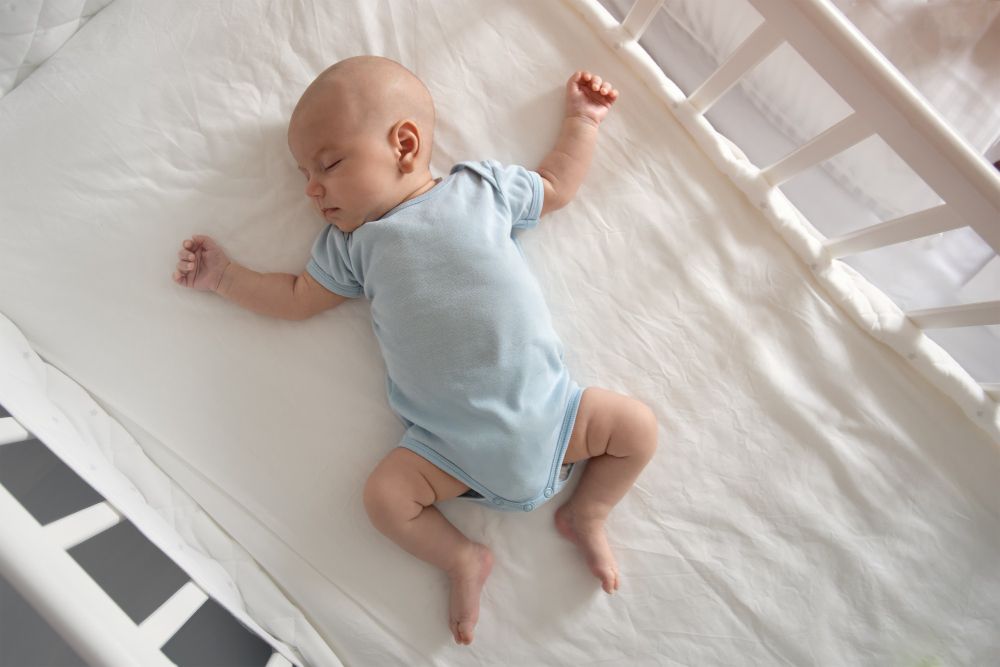
SIDS Awareness Month: Safe Sleep Techniques
SIDS Awareness Month: Safe Sleep Techniques
Sudden infant death syndrome (SIDS), also known as “crib death” or “cot death,” occurs when a healthy baby dies while asleep for no apparent reason. SIDS is the most prevalent cause of death among babies one month to one year of age, with most deaths happening during the first four months.
What Causes SIDS?
Pediatricians and medical professionals do not know what causes SIDS. Still, experts suspect that SIDS can occur when babies have problems waking up or when their bodies have difficulty detecting excess carbon dioxide in the blood.
Research has revealed several risk factors, including laying a baby on their stomach or side to sleep before they turn one year old. Male babies tend to succumb to SIDS slightly more often than females. Also, Native American and African American babies are twice as likely to die from SIDS than other ethnic groups, although the reasons are unknown.
Other risk factors include:
- Being a twin, triplet, or part of multiple births
- Not breastfeeding
- Brain defect, often undetected until an autopsy
- Co-sleeping
- Family history of SIDS
- Low birth weight
- Soft mattress
- Mother under 20 years of age
- Not using a pacifier during sleep
- Old crib
- Overheating
- Premature birth
- Respiratory infection
- Smoking and secondhand smoke
- Soft objects in the crib with the baby
How Can Parents Promote Safe Sleep for Their Newborns?
Rates of SIDS have steadily decreased since 1990. Parents and caregivers can be aware of the known risk factors and take steps to prevent them.
Encourage Back Sleeping
Crib deaths have dropped significantly since experts started advising parents to put babies on their backs. This might not be so easy once the little one can roll over on their stomach. However, babies who roll over on their own can usually sleep safely as long as they are on a firm mattress and there is nothing else in the crib with them.
Avoid Crib Bumpers
Crib bumpers might seem to protect babies, but they are not necessary. Instead, they can cause suffocation when babies roll over, press their faces against the material and suffocate. Even breathable crib bumpers are not safe. Your little one will be fine without one.
Rethink Co-Sleeping
Although sharing your sleep space with your baby can encourage bonding and breastfeeding, it can pose a risk for SIDS. Regular mattresses are not designed for infants and might be soft enough to cause suffocation.
Use a Fan in the Baby’s Room
Poor air circulation and overheating can harm a sleeping baby. Placing fans in the baby’s room could reduce the risk of SIDS by up to 72 percent. Keeping the air moving can also help the child fall and stay asleep.
Don’t Smoke
Quitting smoking is one of the most important things parents and caretakers can do because secondhand smoke can contribute to SIDS. Pregnant women who smoke should quit because smoking can alter a fetus’s brain to make it more vulnerable to SIDS after birth.
Give Your Baby a Pacifier
Some parents’ feelings about pacifiers are mixed. However, pacifiers can decrease the possibility of SIDS because sucking on the pacifier keeps a baby’s brain active and prevents them from stopping breathing. The choice to use a pacifier is up to the parents, and they should never force their baby to take it.
Consider Breastfeeding
Not only does breastfeeding facilitate bonding between mother and child, but it also lowers the risk of SIDS by about 50 percent. Mothers should consider breastfeeding at least through the first six months.
Trying to remember the tips for safe sleep can be overwhelming. Using the ABC acronym, parents and caretakers can remember that babies should:
- Alone—Sleep in the crib, not with a parent
- Back—Lie on their back while sleeping
- Crib—No crib bumpers or other items
Importance of Support for New Parents
New parents who are anxious about their baby’s sleep health can turn to close friends and extended family for support and assistance. Anyone who provides extra caretaking should be aware of the SIDS risk factors and follow the steps that promote safe sleep.
The death of a newborn is devastating to a family. In addition to the trauma from the investigation and autopsy, a baby’s death can strain the parents’ relationship. Several support groups exist, such as Compassionate Friends, First Candle, and MISS Foundation. In addition, people of faith can turn to their churches or worship groups for counseling and help.
Research and materials for this article were compiled, written, and distributed on behalf of the National Public Health Information Coalition. The views and opinions expressed in this blog are those of the various authors and do not necessarily reflect the official policy or position of the National Public Health Information Coalition or its members.
References
- https://vsearch.nlm.nih.gov/vivisimo/cgi-bin/query-meta?v%3Aproject=medlineplus&v%3Asources=medlineplus-bundle&query=SIDS&_ga=2.240779267.1061702434.1635283594-793576931.1635283594
- https://safetosleep.nichd.nih.gov/safesleepbasics/SIDS/fastfacts
- https://pediatrics.aappublications.org/content/129/4/630
- https://medlineplus.gov/ency/article/001566.htm
- https://www.healthline.com/health/sudden-infant-death-syndrome#causes-and-risk-factors
- https://www.cdc.gov/sids/data.htm
- https://www.healthline.com/health/parenting/sids-prevention#8.-Put-your-baby-to-sleep-on-their-back
- https://www.consumerreports.org/child-safety/new-bill-would-ban-crib-bumpers-a8289726274/
- https://pediatrics.aappublications.org/content/100/2/272
- https://pubmed.ncbi.nlm.nih.gov/18838649/
- https://www.cdc.gov/tobacco/data_statistics/fact_sheets/secondhand_smoke/health_effects/index.htm
- https://www.mayoclinic.org/healthy-lifestyle/infant-and-toddler-health/in-depth/pacifiers/art-20048140
- https://pediatrics.aappublications.org/content/123/3/e406
- https://my.clevelandclinic.org/-/scassets/files/org/childbirth/safe-to-sleep.ashx?la=en
- https://www.compassionatefriends.org
- https://firstcandle.org/online-support-groups/
- https://www.missfoundation.org

